2008 The Fourth Modern Nemead
This was the first Nemead with Professor Kim Shelton as Director of the Nemea Center for Classical Archaeology at the University of California, Berkeley. She arranged for the photographs marked below with an asterisk (*) to be taken by Jeffrey Tseng, and has made them available for the Society’s use here. We thank Professor Shelton and the Nemea Center for helping to document our games.

1 Reconstructed view of the locker room (apodyterion). A fundamental part of the revival of the Nemean Games is the time spent by the participant in preparation and cleanup in the ancient locker room. Yet, it was only in 2008 that photographic documentation was made of the preparations of the locker room for the participants, and other parts of the stadium. The image that follows is still not the whole story, but it gives an impression of the work involved before the games.

2 In 1996 a tent needed to be made that would cover the locker room and shelter the participants. Stephen Miller made a model of what would be needed based on the plan of the building, and the need to have enough interior height to pass over the ancient columns, represented by the red pencil.

3 The model of the tent, seen from the south with the door leading to the tunnel passageway, provided the information necessary for tent maker of the 6th Infantry Regiment of the Hellenic Army (Corinth) to make the tent from material provided by a company in Nauplion, Pamona, Inc.

4 Before the tent can be put up, however, a light scaffolding has to be erected to protect the ancient columns as seen here in 2008. Stephen Miller is ascending the ladder which is steadied by George Nikitakos while Elias Skazas has readythe next piece of wood that Miller will put in place.
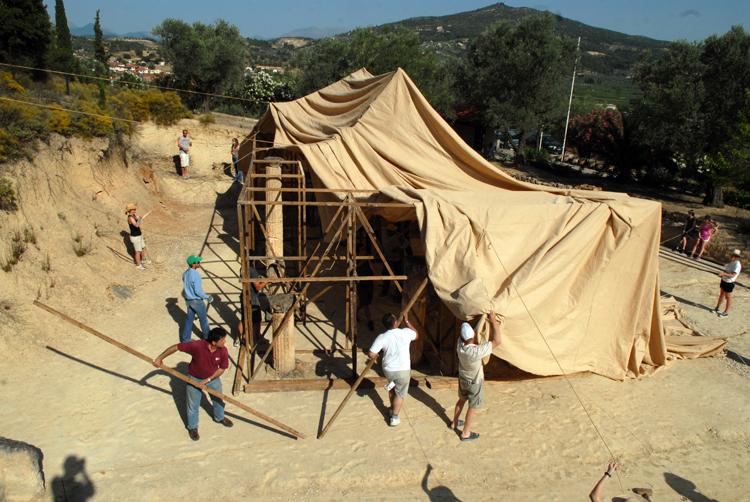
5 The raising of the tent requires about 30 people and careful patience as the fabric has to be lifted over the scaffolding and the ancient columns.
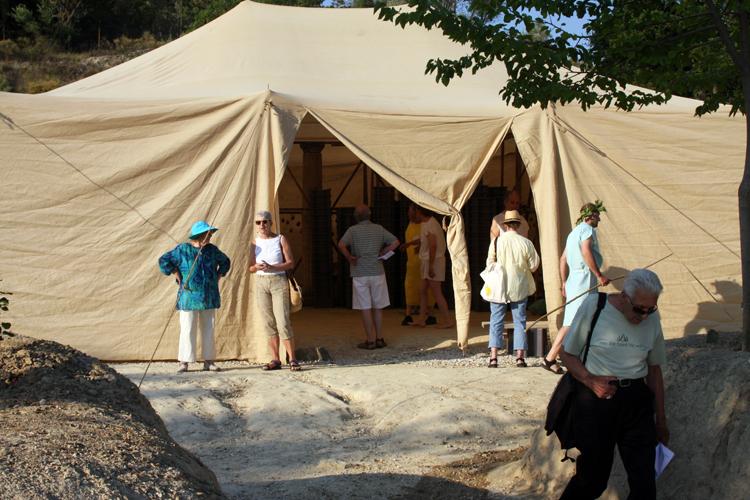
6* The tent is up and open for business and the first runners begin to change their clothes.
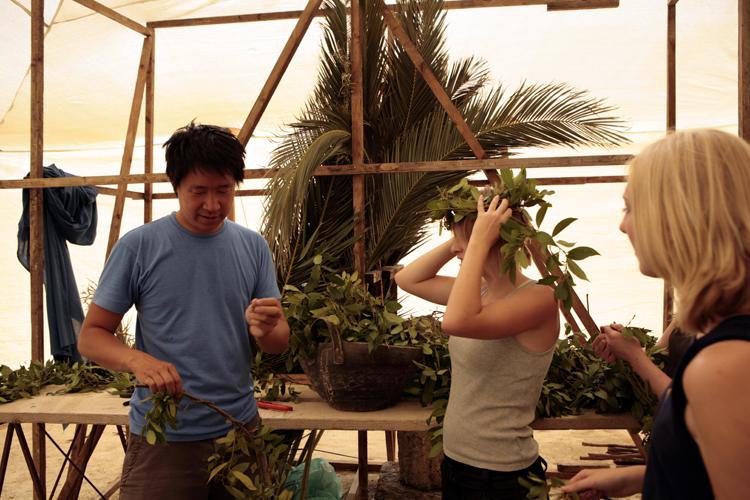
7* The tent also provides a work place for students from the University of California at Berkeley who prepare laurel wreaths for the judges and heralds.
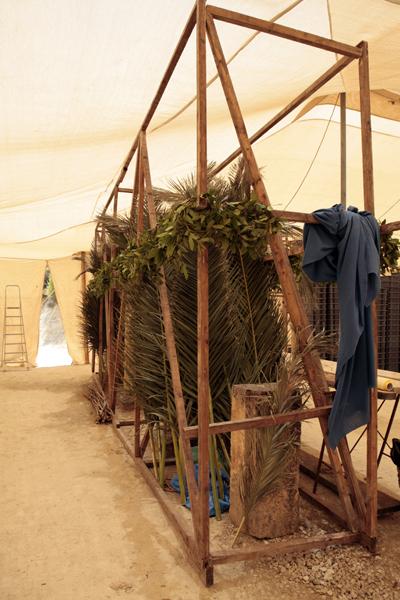
8* The palm branches await the victors.
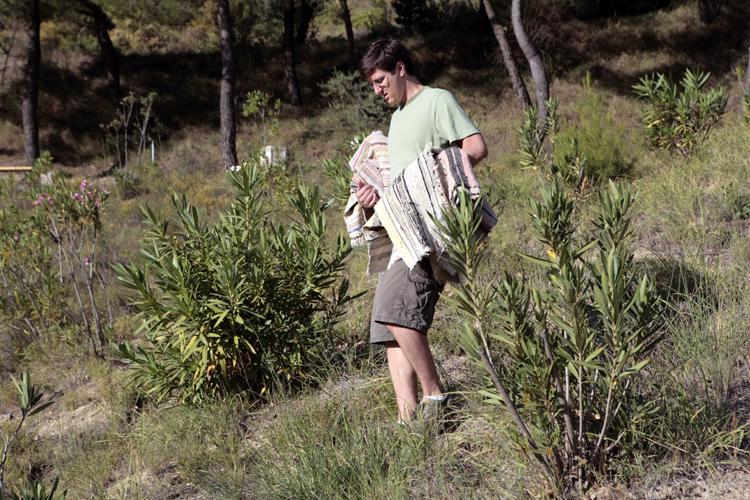
9* Berkeley student, John Lanier, carries out old rugs to be spread for the spectators.

10* Elias Skazas, local workman and longtime caretaker of the archaeological site, carries another load of spectator “seats.”

11* Elias Skazas also stacks a supply of wood that will be burned on the Altar during the day.

12* The bowls of Nemean Earth that will cover the flame at the Closing Ceremony are already at the Altar.

13* Students from the University of California at Berkeley paint the lines that divide the lanes on the track.

14* Stephen Miller, with assistance from a Berkeley student, sets up the starting mechanism (hysplex).

15* New rope will insure against starting mechanism failures.

16* Judge George Bouchoutsos, accompanied by Judges Tassos Tagaras, Nikos Zoes, and George Andrianakos, and by the Λύκειο Ελληνίδων Κιάτου carries the flame from the Temple of Zeus to the Stadium.

17* The Λύκειο Ελληνίδων Κιάτου arrive in the stadium together with the flame.

18* The speech of welcome at the Opening Ceremony is delivered by Mayor Kostas Kalantzes with Judges Michales Velentsas (former Mayor), Panayiotes Karyotes, and Spyros Bouchoutsos.

19* Former Governor of the Korinthia and current Member of the Parliament, Angelos Manolakes, passes the flame to Mayor Kalantzes while Slave Georgios Nikitakos is ready to help.

20* Slave Georgios Nikitakos assists Mayor Kostas Kalantzes with lighting the Altar.

21* During the Opening Ceremonies, Kim Shelton (Director of the Nemea Center for Classical Archaeology at the University of California at Berkeley) greets Aristoteles Kalles (first President of the Society for the Revival of the Nemean Games) who talks with Stathis Skleris (then President of the Society for the Revival of the Nemean Games). Kostas Lambropoulos (then member of the Board of Directors of the Society) watches the proceedings at the altar.

22* In the locker room Slaves Ioannes Nakes (left) and Kostas Tagaras help athletes to dress for their participation.

23* Peace Officer (Mastigophoros) Anastasios Bakasetias shows athlete where he should go to swear his oath.

24* Judge Haris Kyriakos is ready for the games to begin.
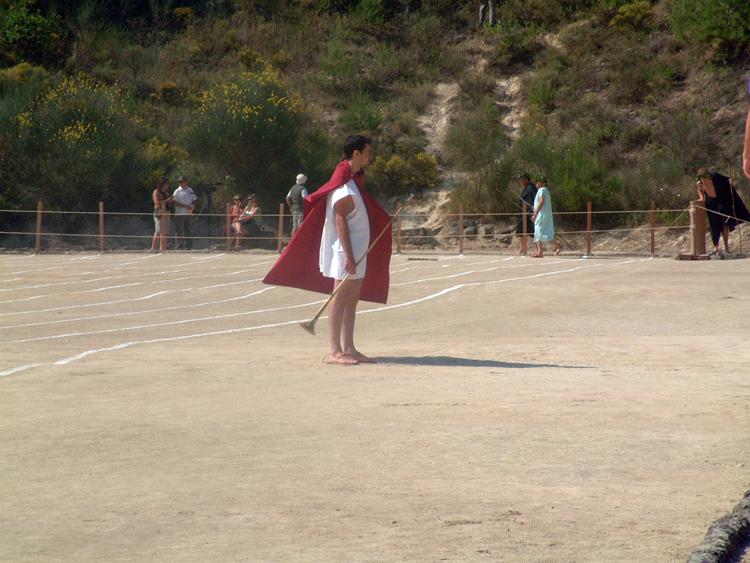
25 Trumpeter Panayiotis Dimarakes is ready for the games to begin.
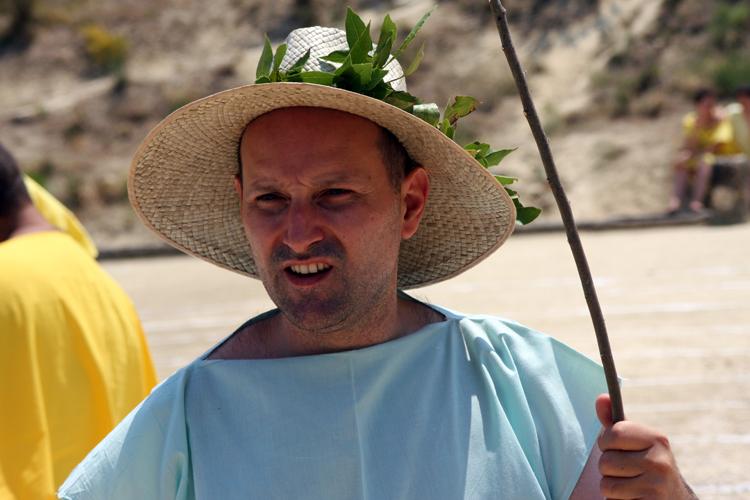
26* Peace Officer Anastasios Bakasetias is ready for the games to begin.
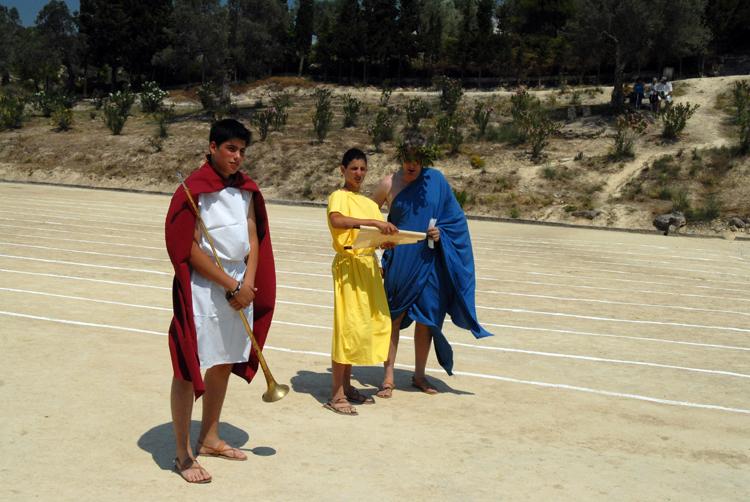
27 Trumpeter Alexandros Basaniotis has called the crowd to attention so that Herald Brady Kiesling can announce the names of the competitors from the list held by Slave Ioannes Schoinohoritis.
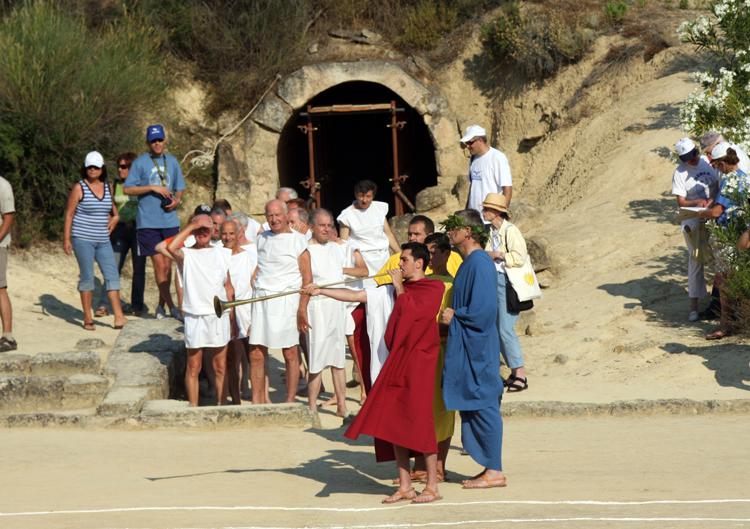
28* The trumpet sounds and the first group of athletes is ready to enter the stadium.
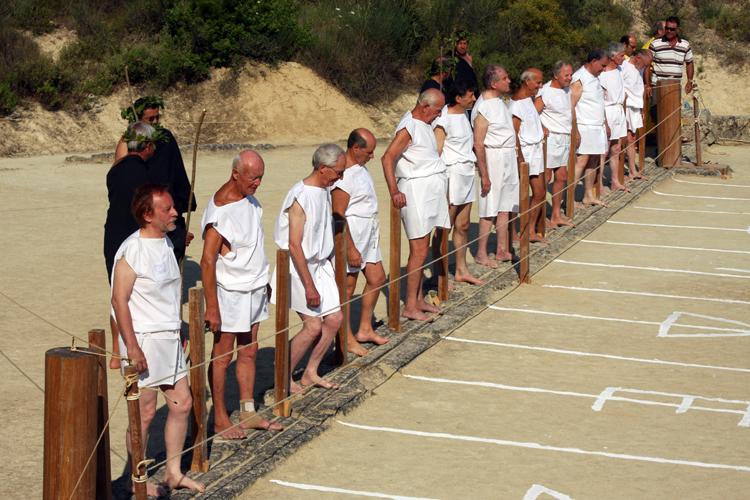
29 The first group, led by 84-year-old George Korkas in lane 5, takes its place at the starting line.
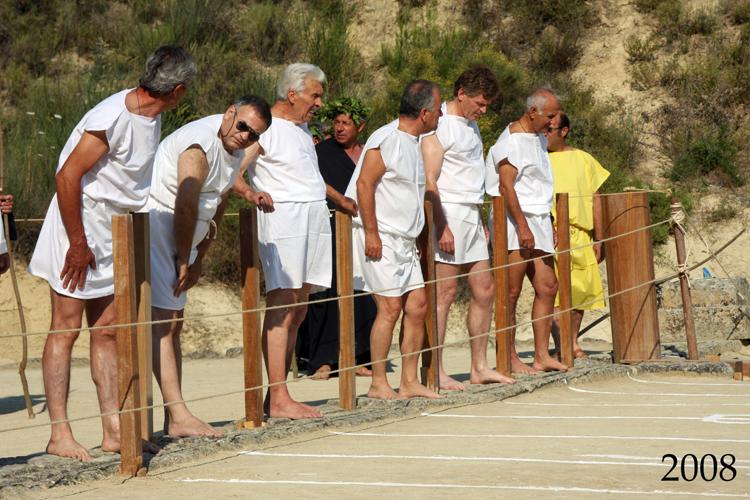
30 The second group, with Professor Athanasios Maskaleris in the third lane and Angelos Manolakes in the fourth, readies for the start.
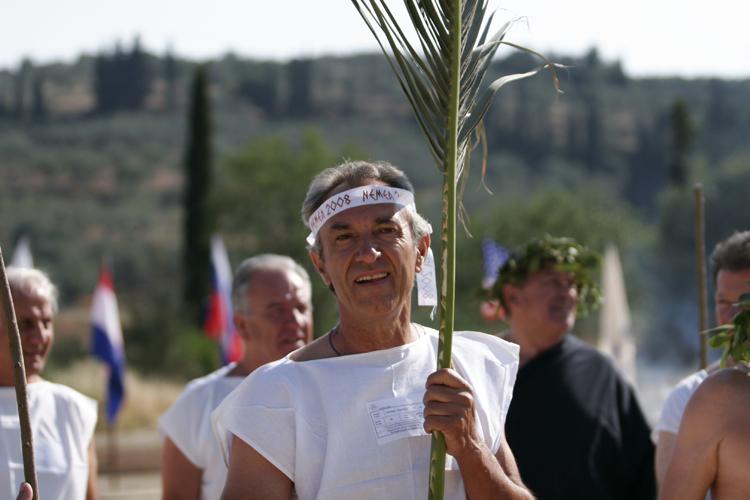
31* The victor of the second group is the guard of the antiquities at Mycenae, George Chronis. He also won at Nemea in 2000, in a younger age group, of course.
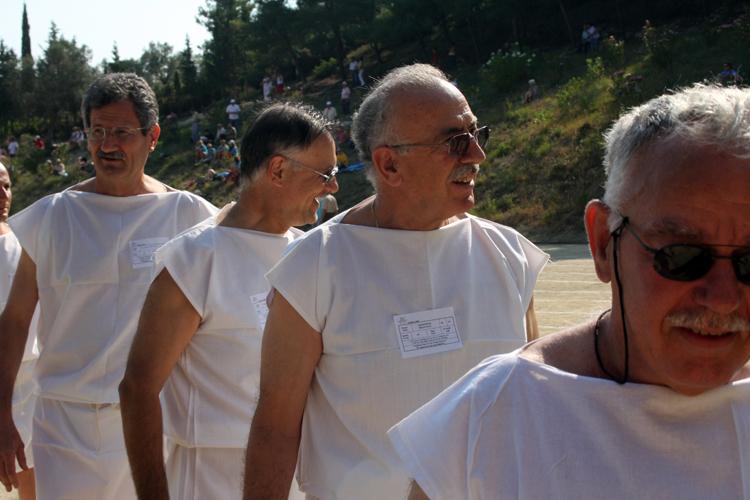
32* The next group enters the stadium. At the left is Ioannis Flessas, Treasurer of the Society in 1996 and again in 2011.
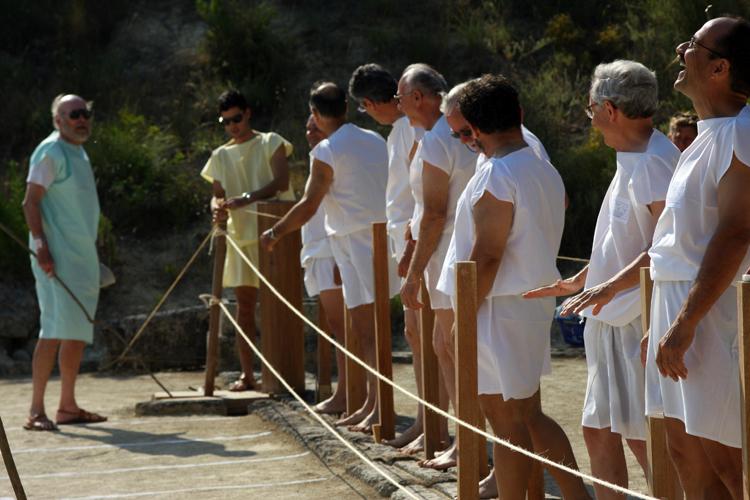
33* The third group takes their places at the starting line. Third from the far end is Ioannis Flessas. The Slave with “ancient” watch and sunglasses is Nikos Benekos, who won the first modern race in 1994 and who was on the 2004 poster. The Peace Officer (Mastigophoros) at the left is Bill Taylor whose students from Marin County in California helped to test the starting mechanism (hysplex) in 1993, and the course of the Footsteps of Herakles in 1995.
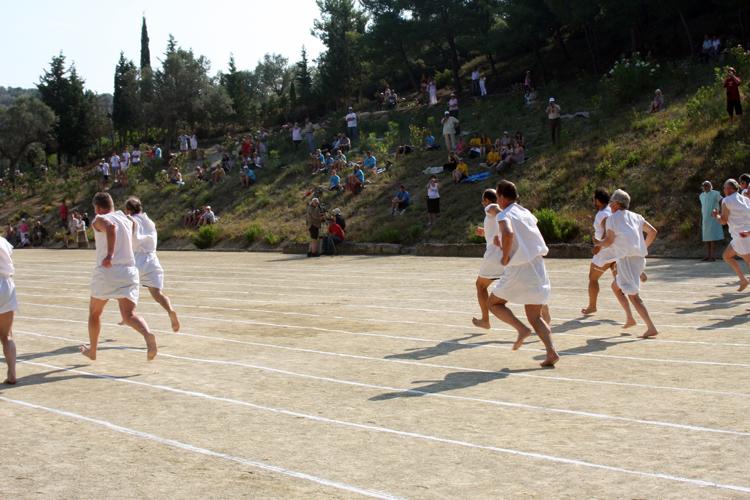
34* The third group is racing, but Ioannis Flessas is not visible.
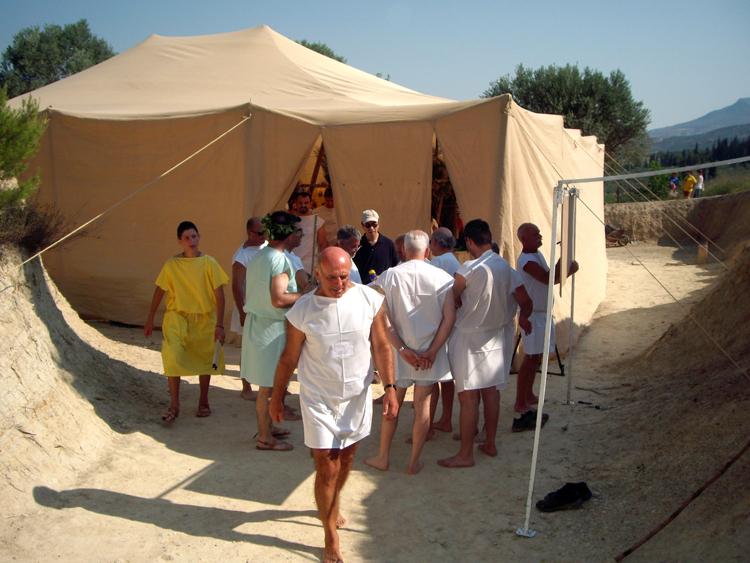
35* A group assembles outside the locker room while Slave Ioannis Schoinochoritis (left) takes the list of their names (scroll, left hand) out to the herald on the track. Former President Aristoteles Kalles gives instructions while Peace Officer Demetrios Dimopoulos (green) stands ready to enforce them.
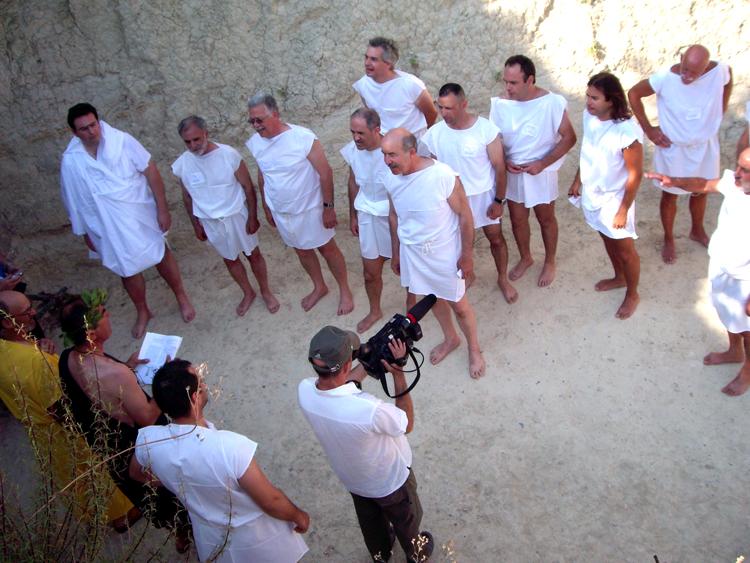
36 The oath is administered by Judge Panayiotis Papadopoulos assisted by Slave Stephen Miller. The known participants from the left are: Ares Matthaiou, George Kostouros, Pantelis Koventaris, and Professor Paul Christesen (behind).
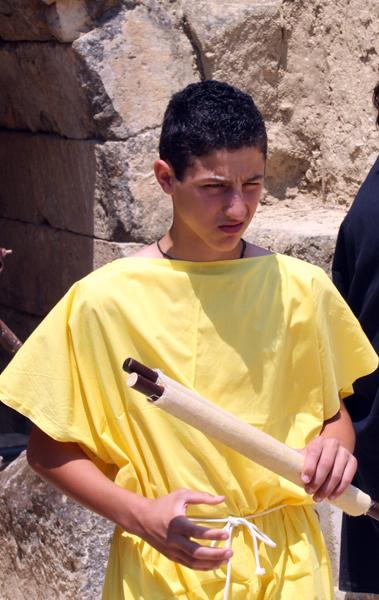
37* Slave Ioannis Schoinochoritis carries the scroll with the list of names in this group out of the tunnel to the track.
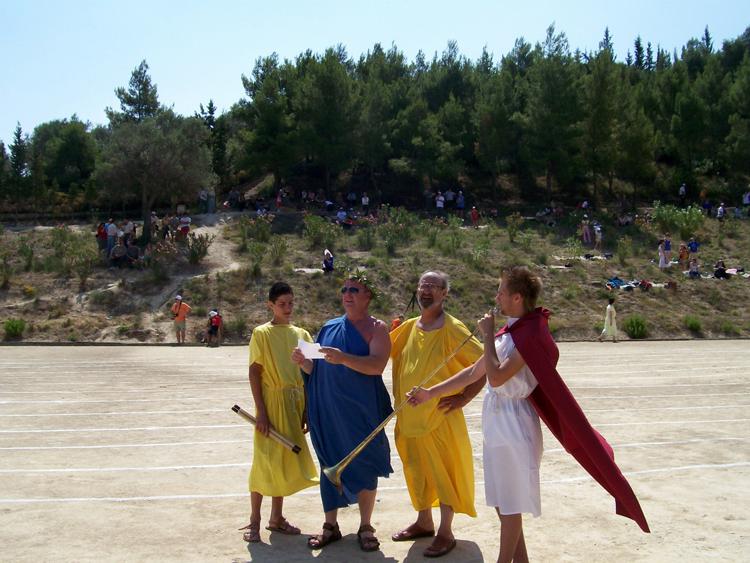
38 Trumpeter David Lagka sounds the call to attention while Herald Dionysios Grivas prepares to read the names of the runners from the list provided by Slave Ioannis Schoinochoritis. Slave Stephen Miller is ready to help.
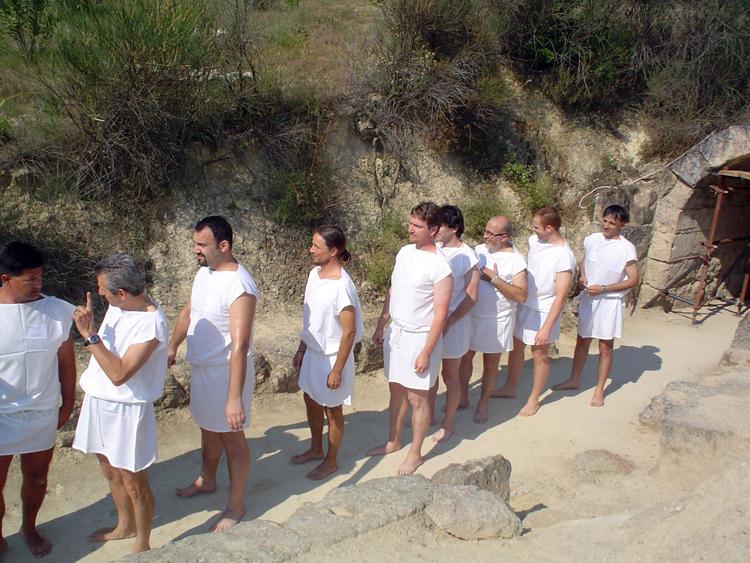
39* The next group enters the stadium.
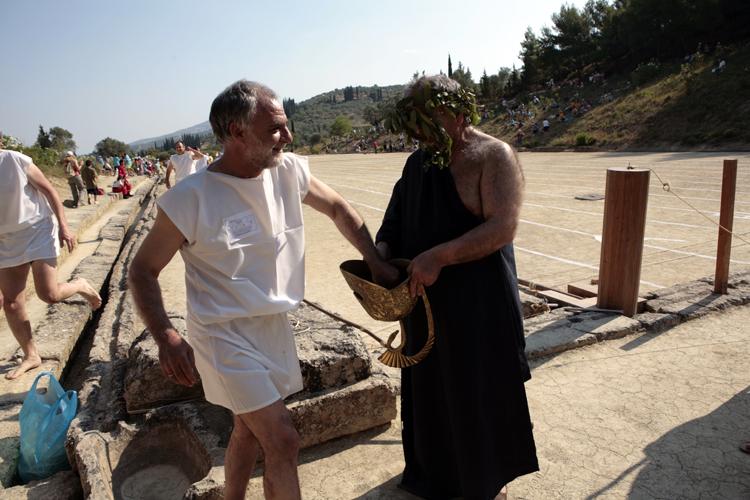
40* George Kostouros, Vice-President of the Society, draws his lane assignment from Judge ???
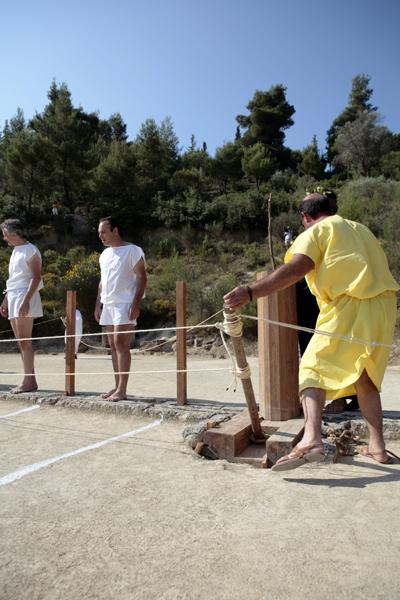
41* Slave Apostolos Delis cocks the arm of the starting mechanism (hysplex) while runners, including Professor Paul Christesen at the left, wait for the signal to place their feet.
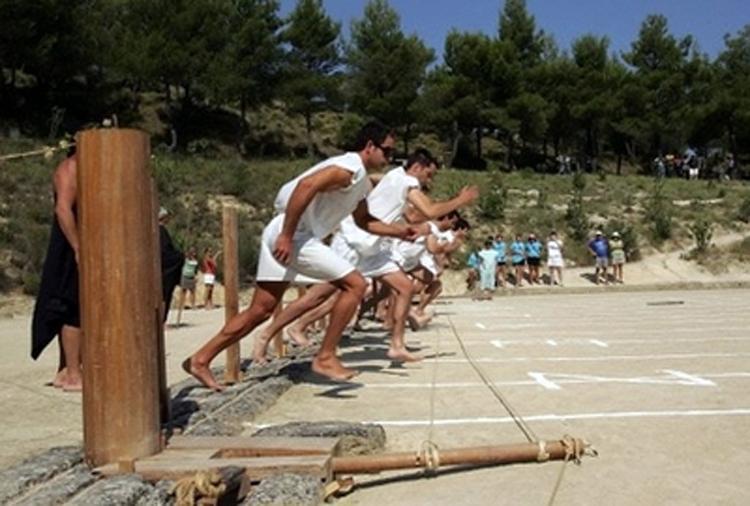
42* The starting mechanism’s barrier cords are down and the race is on!
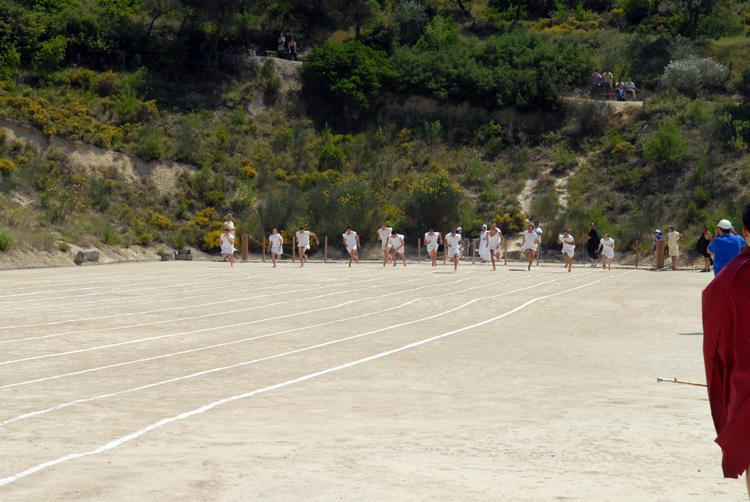
43 Racing down the track.
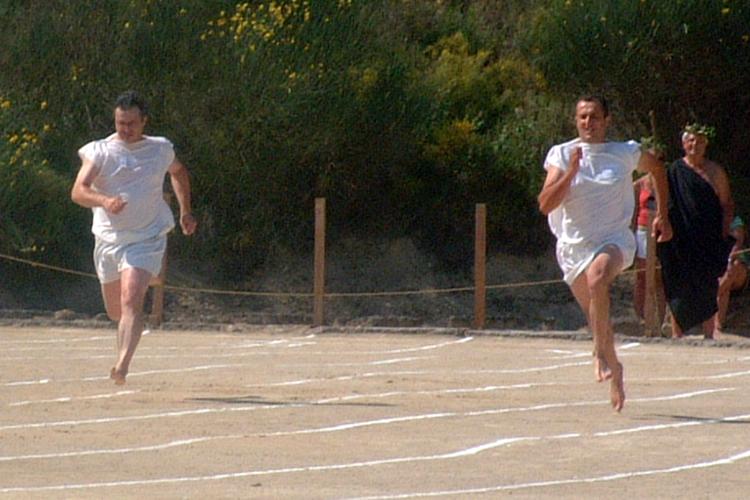
44 The winner of this race will be George Bakasetas, electrician from Petri of Nemea (right).
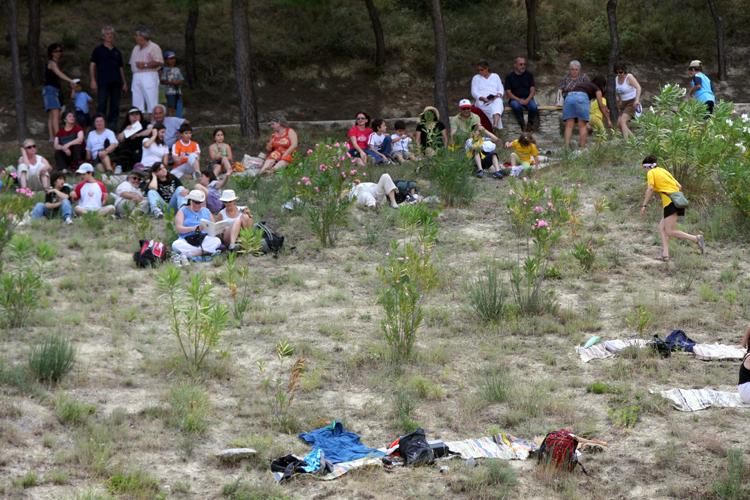
45* Meanwhile, the crowd lounges on the slopes and watches Grandpa and Grandma and Dad and Mom and Junior and Sister run like ancient Greeks.
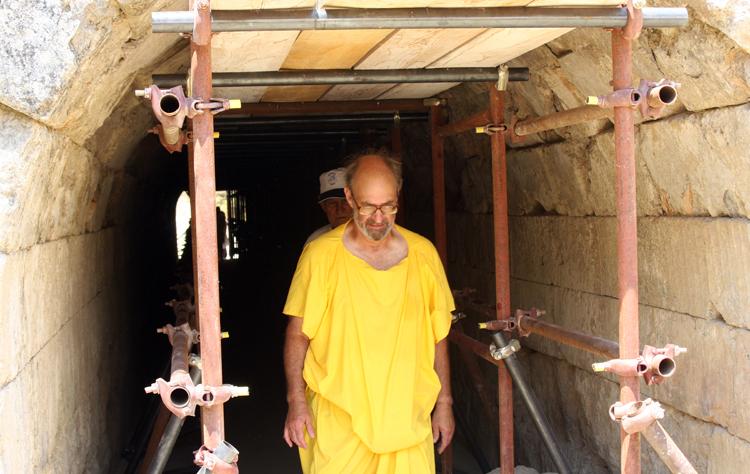
46 It is time for a new race and Slave Stephen Miller comes back to the track followed by George Bouchoutsos, then Vice-President of the Board of Directors of the Society.
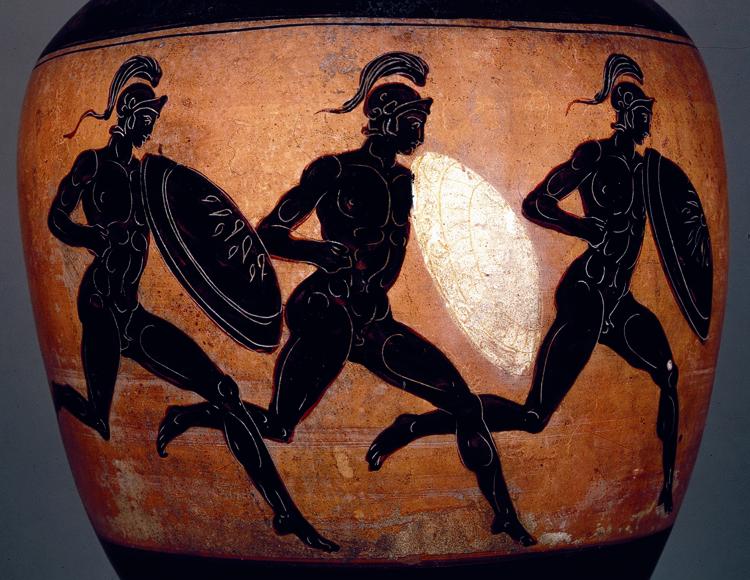
47 In 2008 there was an addition to the events: the race-in-armor (hoplitodromos). This came about because of the request of a group known as Spartan Battalions to participate in the revival. This is a cultural society with the purpose of reviving ancient Greek military costumes and customs, especially at the time of the Persian Wars.
Because an event known as the hoplitodromos was introduced into the Olympic Games in 520 B.C., and probably at about the same time at Nemea, it seemed possible that the Spartan Battalions might run that race which was two stadia in length and involved running with a shield and wearing a helmet as can be seen on many ancient vases, including a Panathenaic Amphora from 323/2 B.C. now in the Louvre.
The absence of body armor and of offensive weapons should be noted. Indeed, the truce (ekecheiria = holding back of arms) which protected the ancient games precluded such weapons during the games. It was agreed with the members of the Spartan Battalions that they might run such a race at the revived Nemean Games.
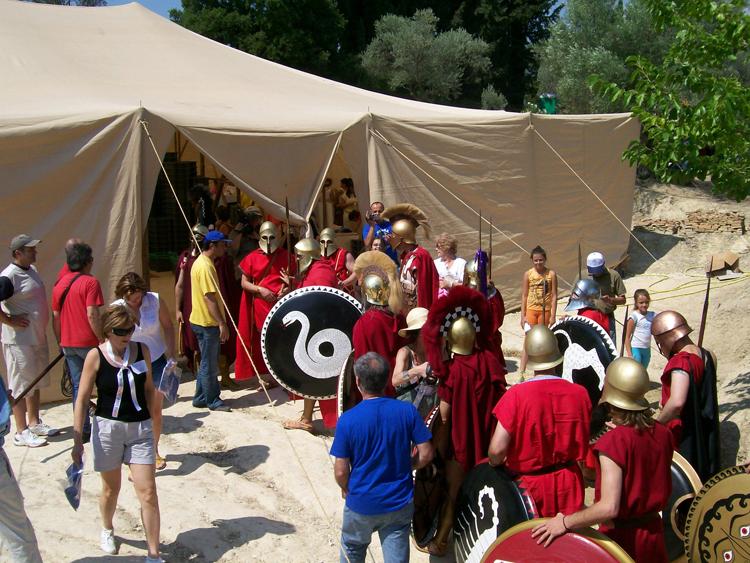
48 The Spartan Battalions arrive at the locker room, but with spears and swords. After some discussion, they agree to stack their weapons outside the stadium, and to run barefoot.
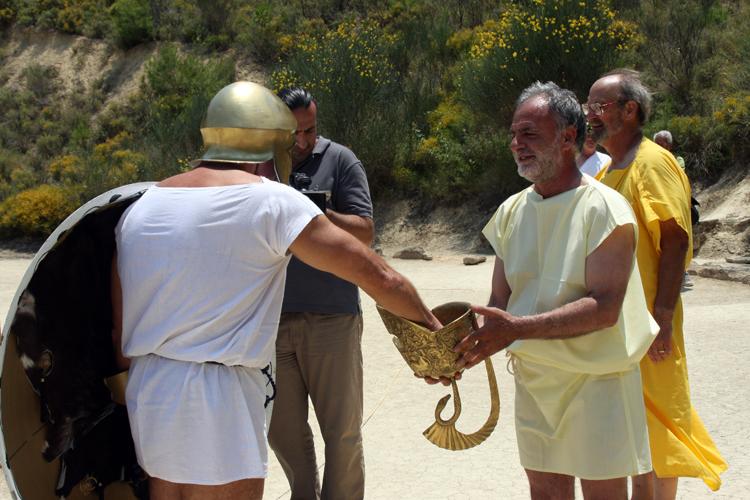
49* A member of the Spartan Battalions draws his lane assignment from the helmet held by Slave George Kostouros while Slave Stephen Miller watches, as does an unknown cameraman.

50* Six runners in the race-in-armor are in their lanes at the starting line, and Slaves George Kostouros (foreground) and Stephen Miller cock the arms of the mechanism while Slave George Nikitakos and Judges ??? and ??? watch.
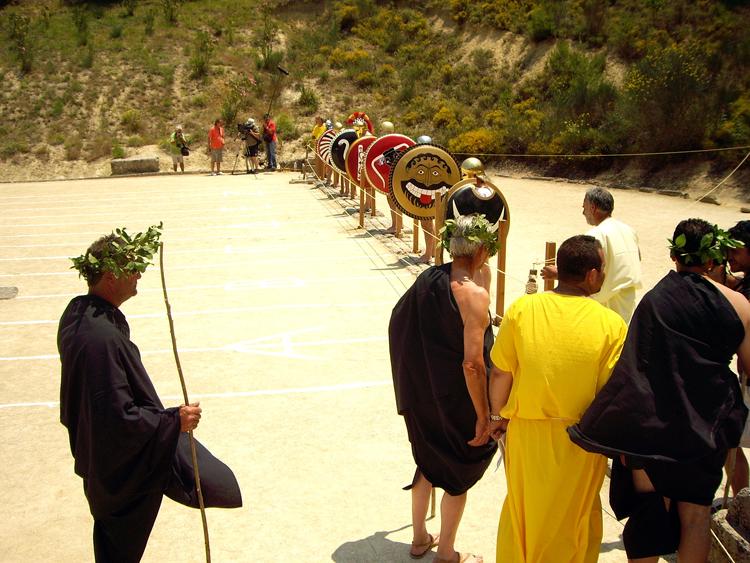
51* The starting mechanism (hysplex) is ready and the race about to begin.
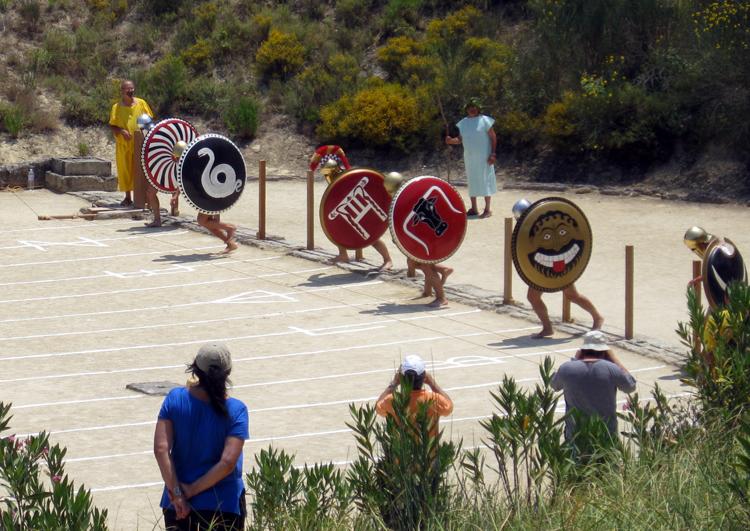
52 The barrier cords of the starting mechanism are down and the runners are off.
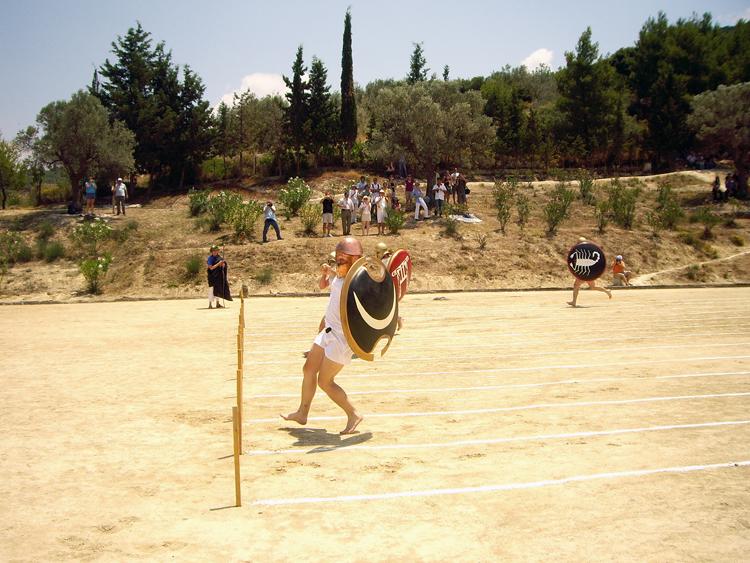
53 Each athlete runs down in half of his double lane, turns sharply around a post, and returns to the starting line (now the finish line) in the other half of his lane.
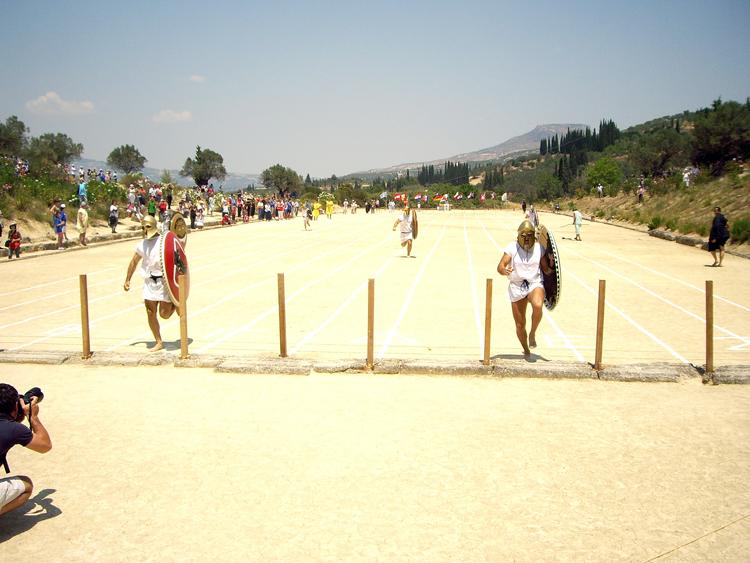
54 It is a photo-finish with the runner on the right no more than half a step ahead.

55 The winner receives his ribbon.
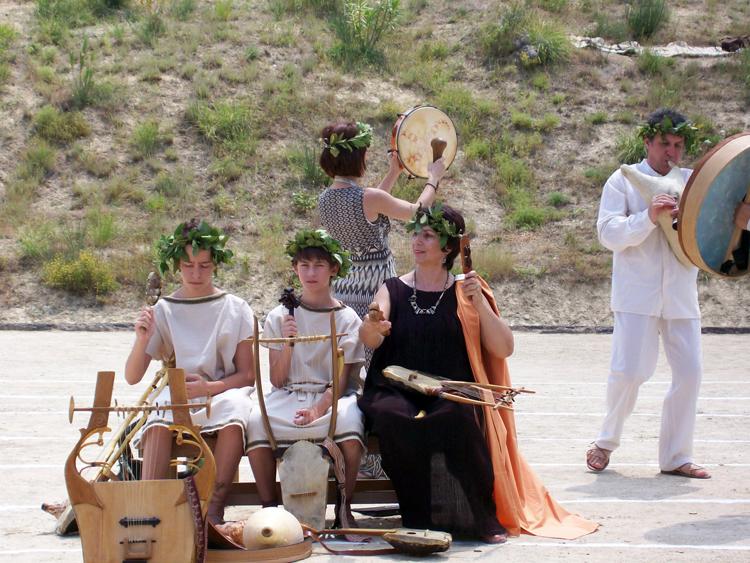
56* While the locker room empties of men, and women take their place, ancient music fills the stadium from the group LyrAvlos whose leader, Panayiotes Stephos (here playing the bag-pipe at the right) makes the instruments.
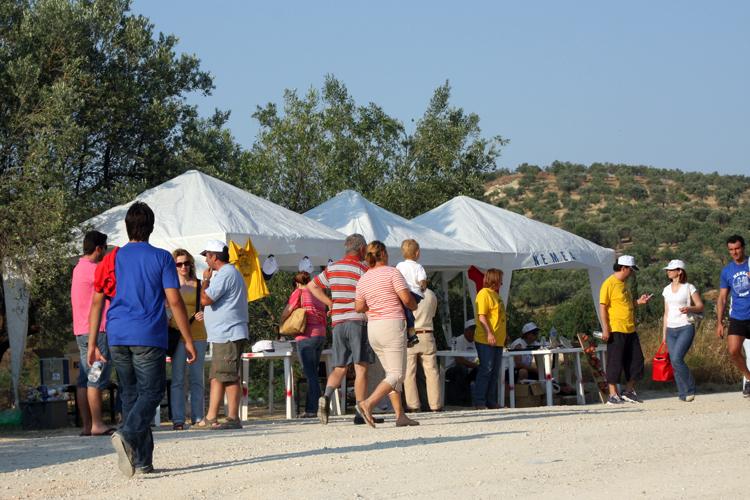
57* Outside the stadium, memorabilia of the Fourth Nemead are available.
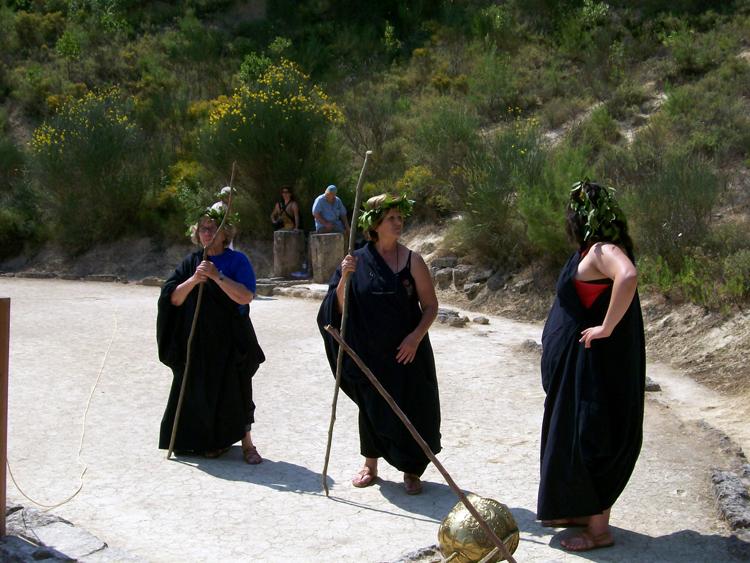
58 Some of the Hellanodikes for the women’s competition take their places at the starting line. From the left: Aglaïa Argyropoulou, Konstantina Kalkounia, ????
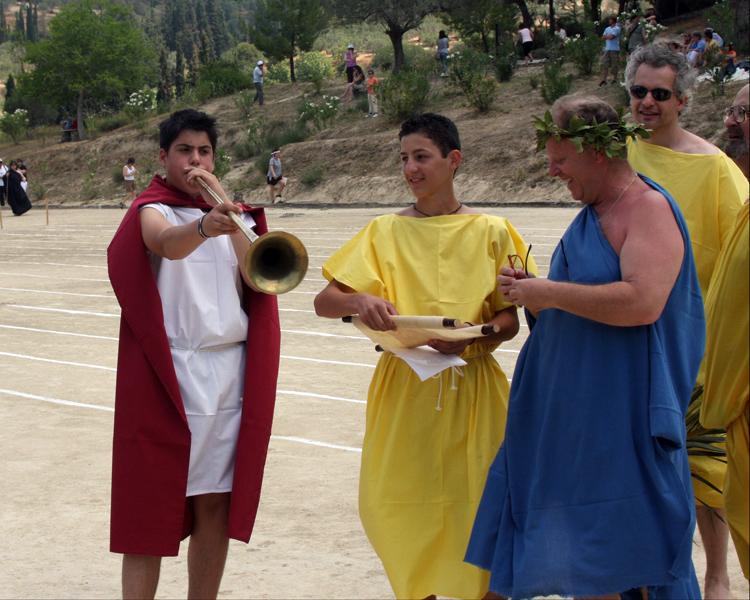
59* The Trumpeter, Alexandros Basaniotιs, calls the crowd to listen to the Herald, Dionysios Grivas, announce the next participants from the list held by Slave Ioannis Schoinochoritis, while Slave Paul Christesen watches.
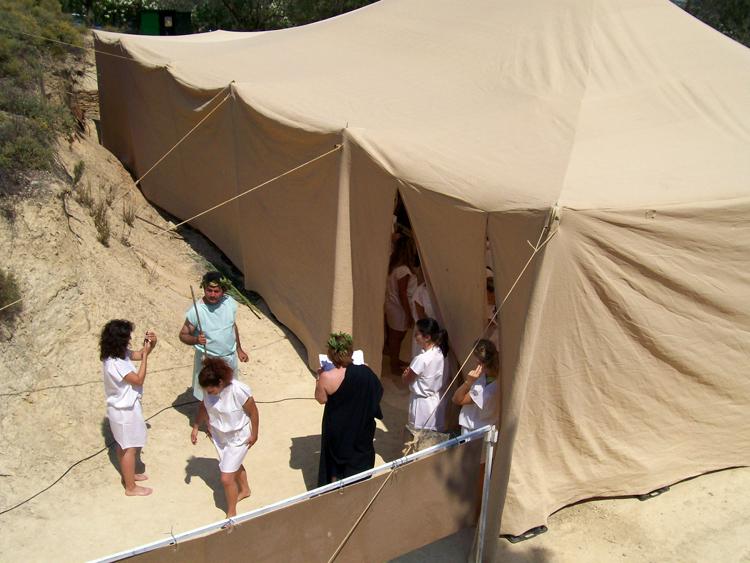
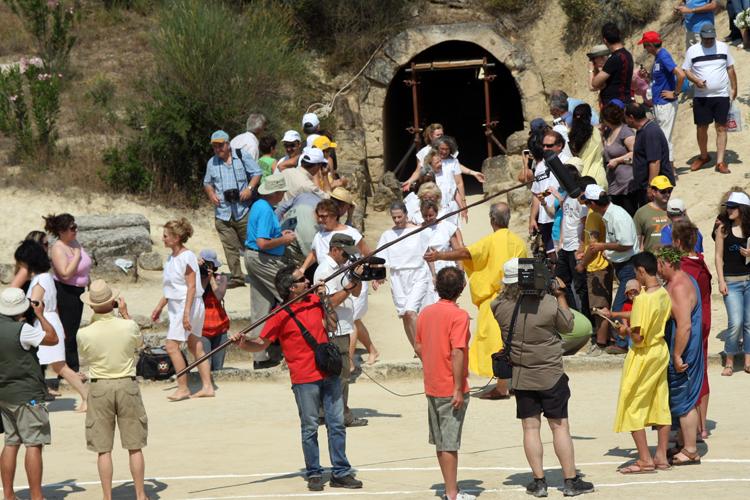
61 The women enter the stadium as their names are called by the Herald Grivas (in blue), nearly overwhelmed by cameras.
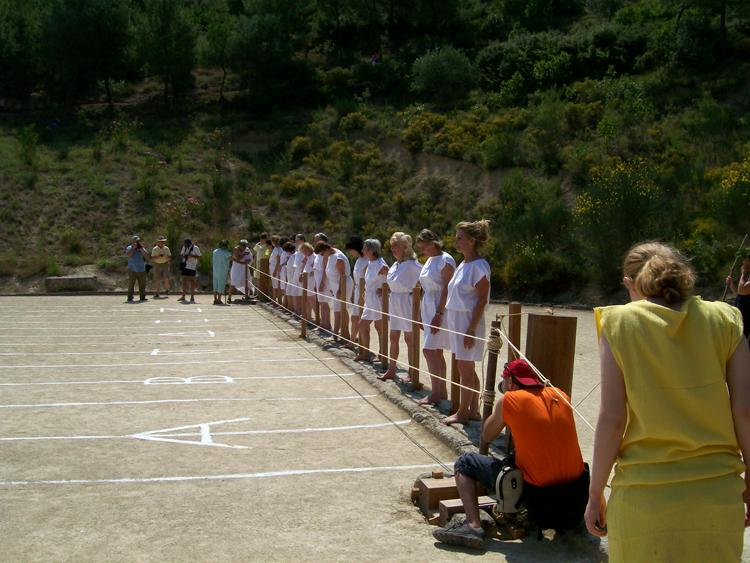
62 Women at the starting line, but the Starter (Aphetes) Antonis Kalkounias at the far end has to make adjustments to the mechanism.
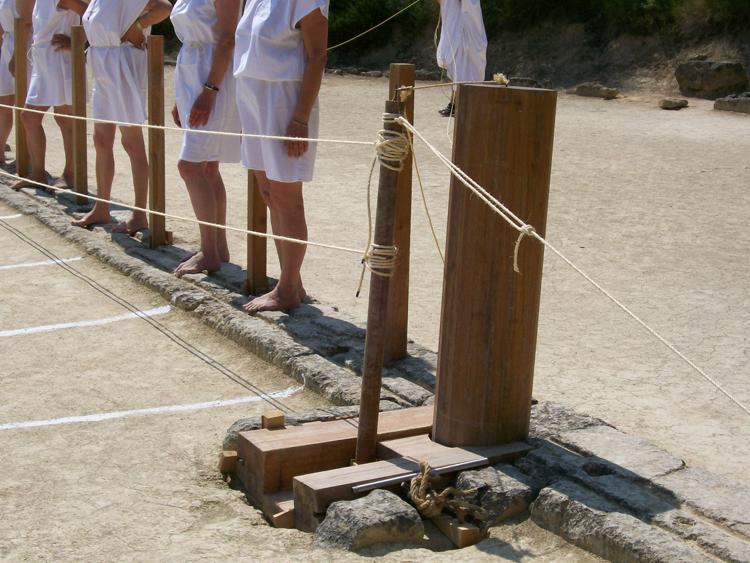
63 Modern women’s toes in the ancient starting grooves – or at least most of the toes are in the grooves.
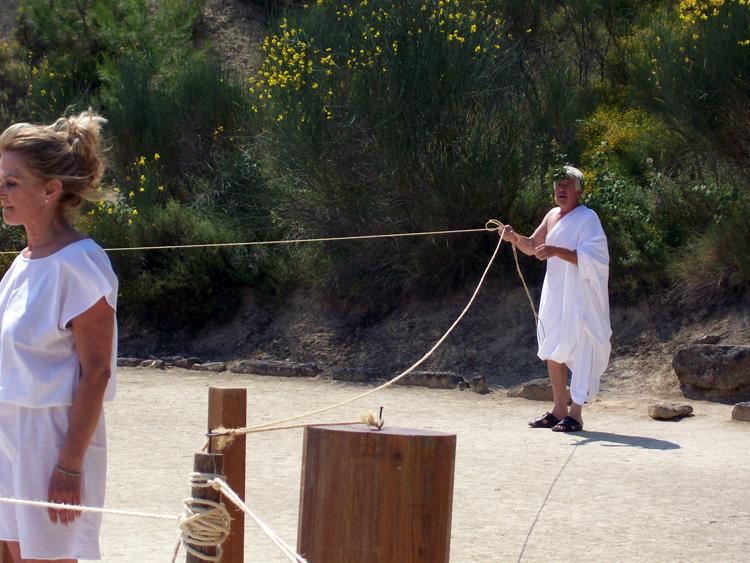
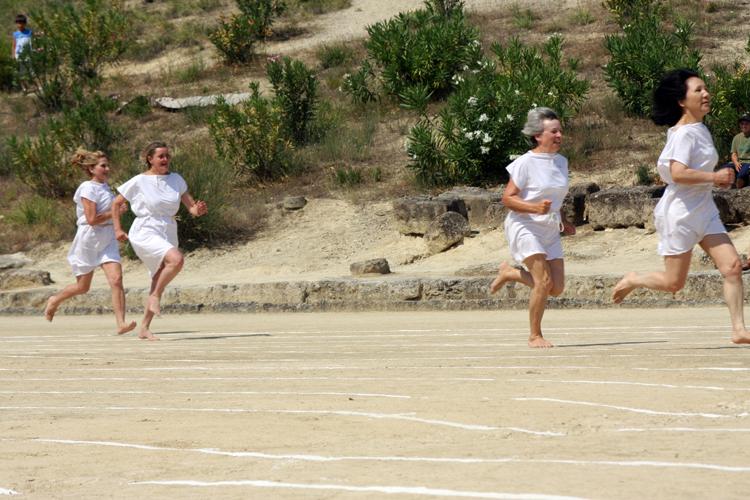
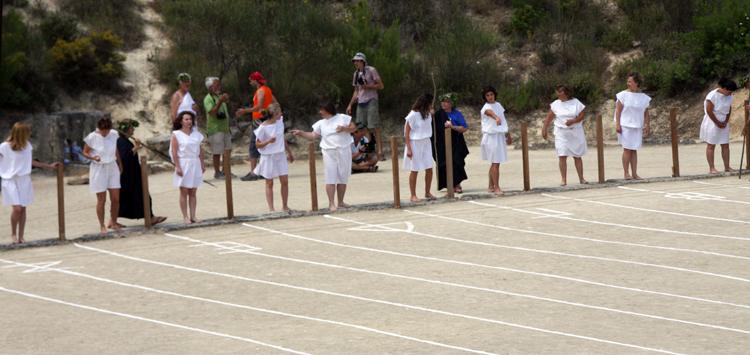
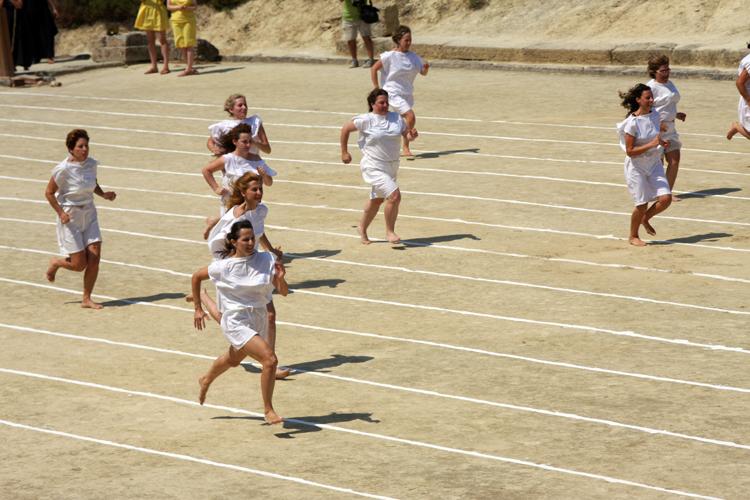
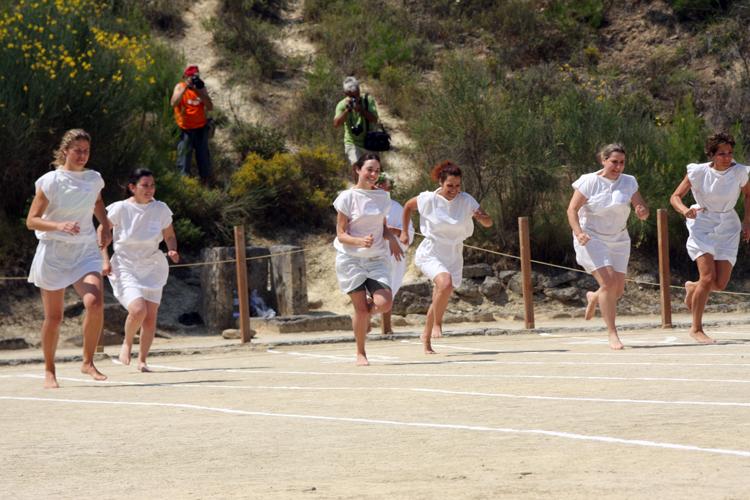
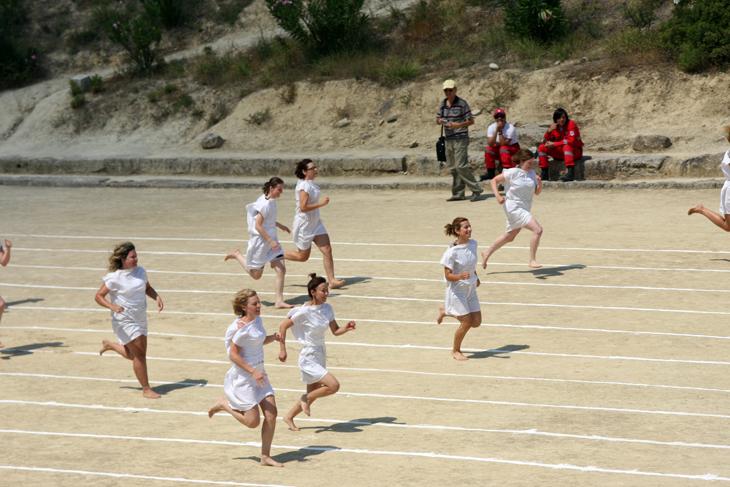
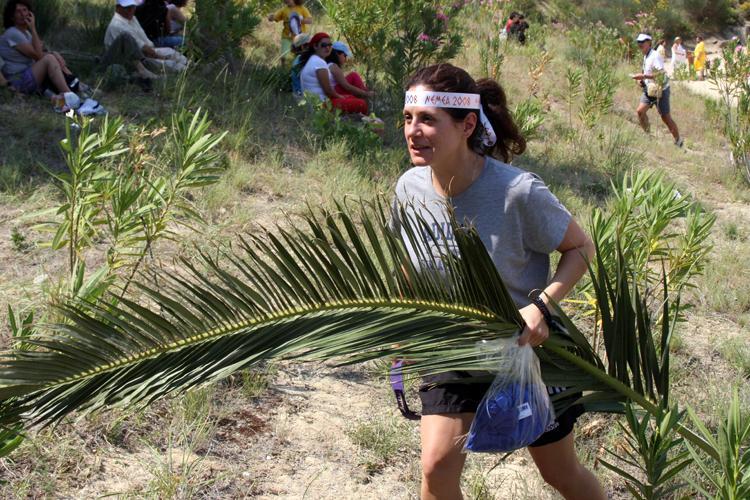
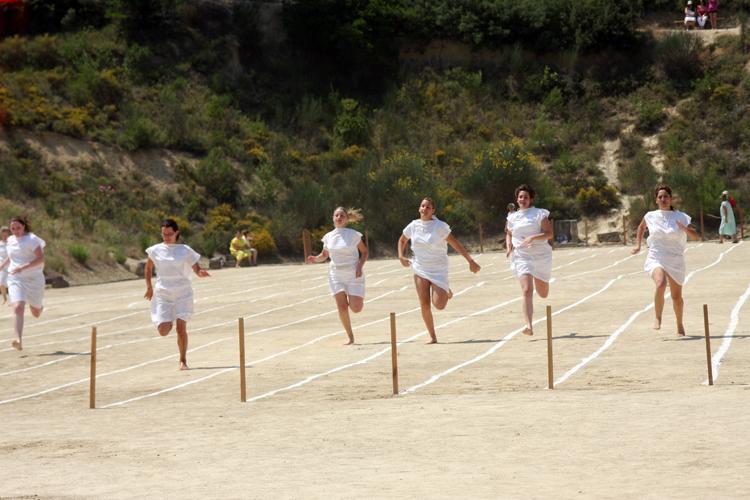
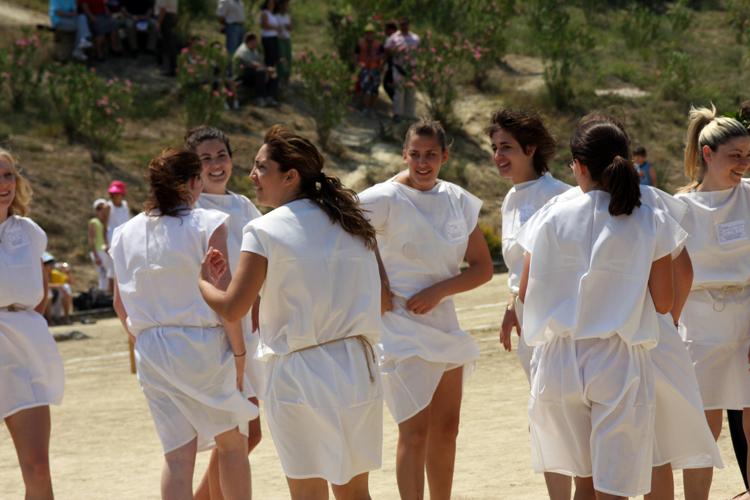
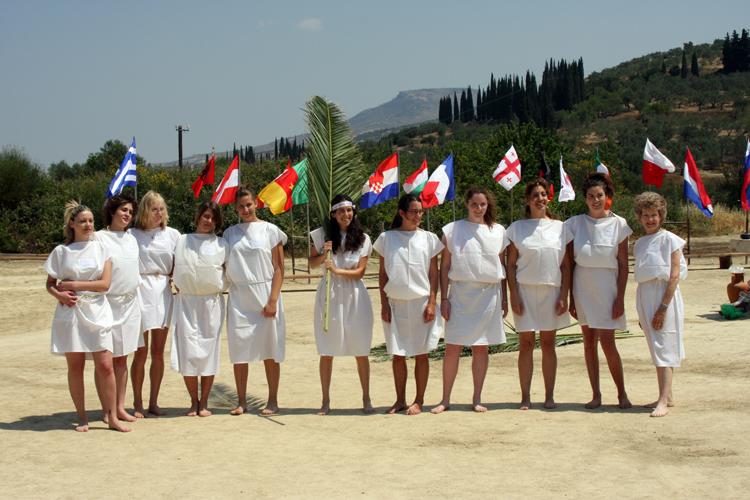
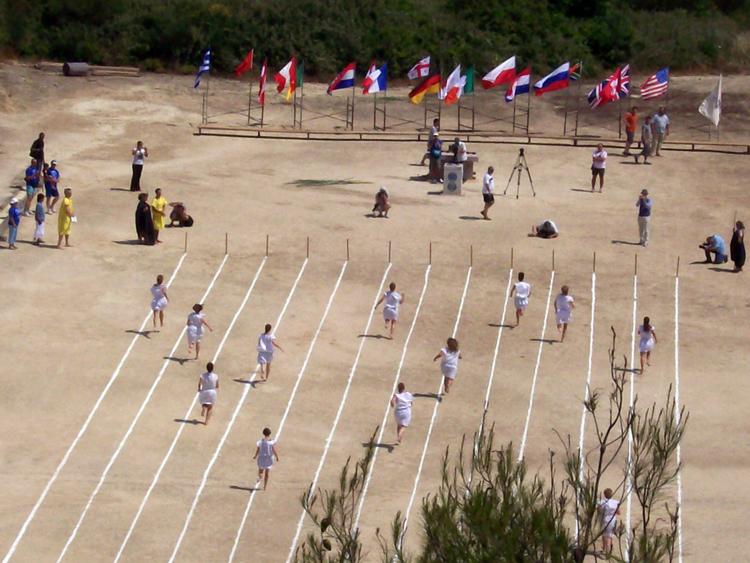
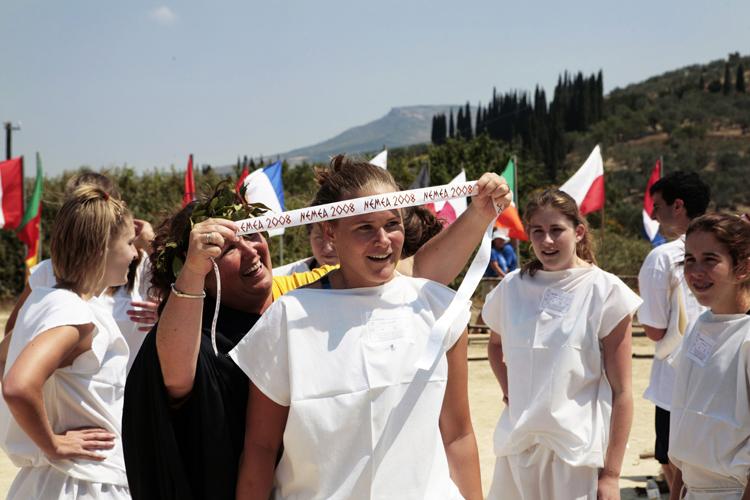
75* Judge Kim Shelton, Director of the Nemea Center for Classical Archaeology at the University of California at Berkeley, ties the victory ribbon on Emily Steffen from the University of Colorado with students from Berkeley Lindsey Mazurek (left), Laura Carlson and Jenna Zack.
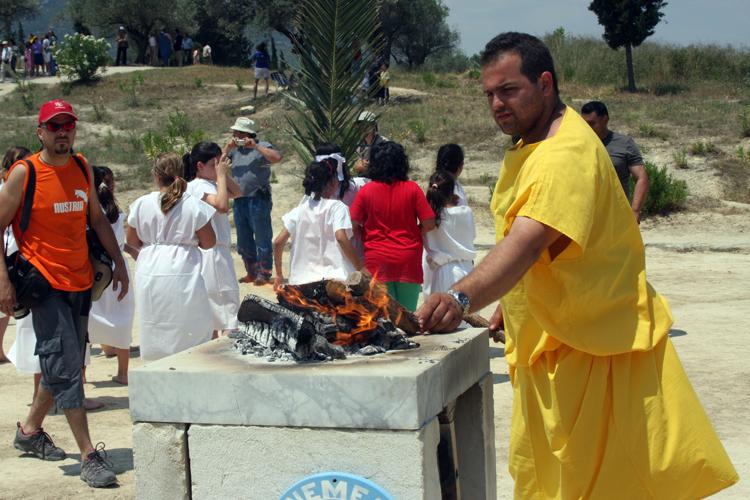
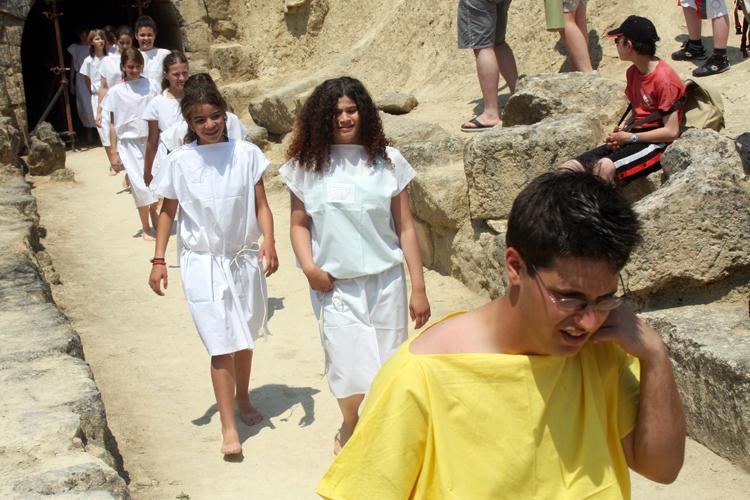
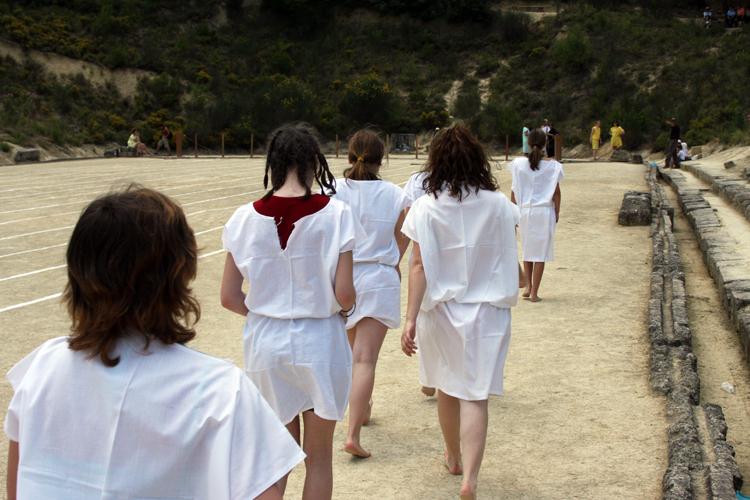
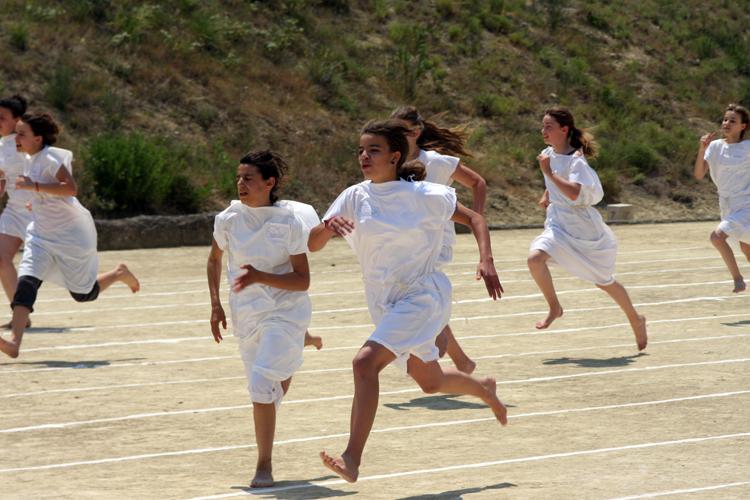
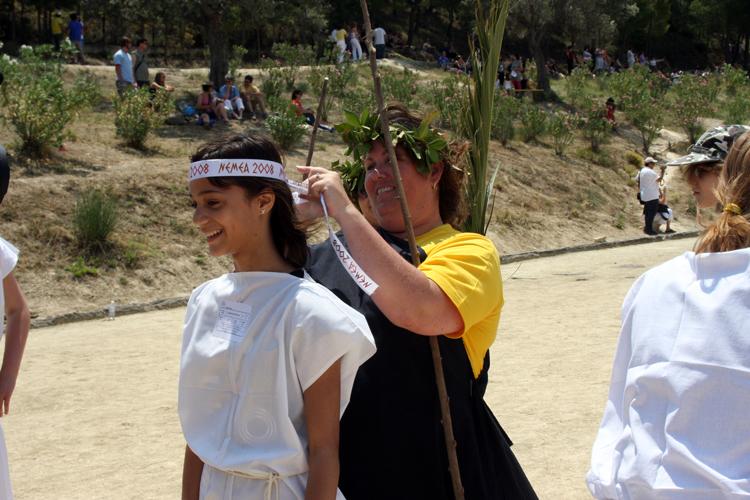
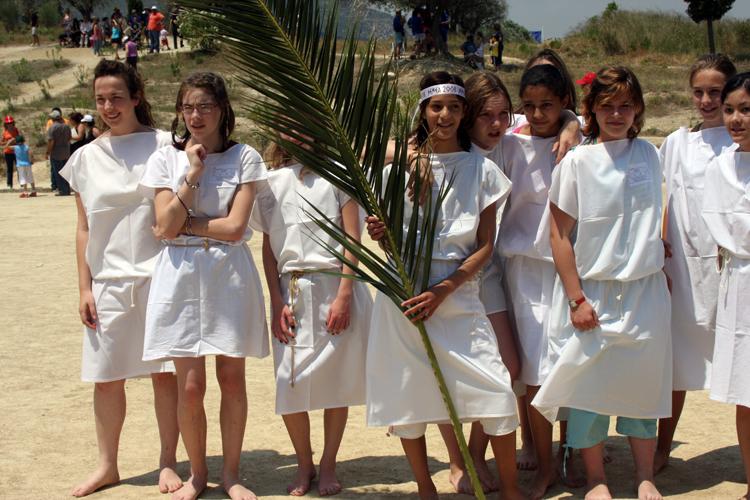
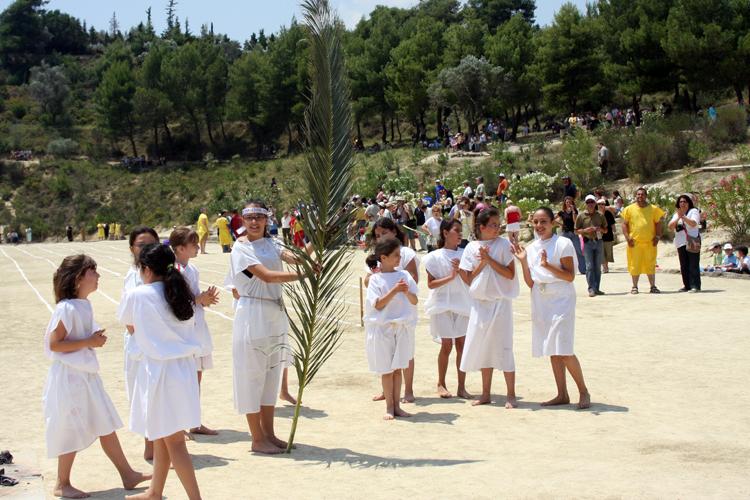


84* Young girls running.


86 Young boys enter the stadium


88 Young boys running.

89* Runners of the Footsteps of Herakles enter the stadium

90 Runners entering the Stadium are directed to run down to and around the Altar and then back on the far side of the track to the starting/finishing line.

91 Heralds George Kostouros and Stephen Miller lead the way for harpist Dianne deLaet to the closing ceremonies.

92 The victors of the Fourth Nemead await their victory crowns of wild celery.

93 Heralds George Kostouros and Stephen Miller read the Prayer to Nemean Earth at the closing ceremonies. Trumpeter Panayiotes Dιmarakes and Slave Tassos Tagaras wait in attendance.

94* After the games the ladies of the village of Ancient Nemea provide a meal for all the participants. From the left: Konstantina Kalkounia, Katerina Kaskantame, ???, and (behind table) Vaso Zavitsa.

95 Brady Kiesling, former student at Berkeley and Nemea excavations staff member writes in the “Athens News” of his experience at the Fourth Nemead in 2008.